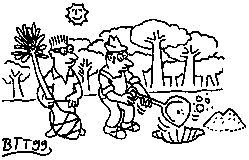After the Second World War, in the Italian Tyrol they decided to carry out a proposal from the times of tyrant Benito Mussolini, which had never been implemented.
The suggestion meant to carry out the reforestation of the mountains, involving the intermunicipal plots and those belonging to private owners of woods. The measure was never carried out because the landowners did not agree and they put pressure on Mussolini so that he gave up implementing it.
After the war, De Gasperi realized that in the Tyrol there was a very strong nationalistic reaction against the Italian Government and decided to grant a large autonomy to the territory, granting it important economic resources. Besides, he decided to implement the proposed reforestation of the Tyrol, starting with the intermunicipal woods, and excluding the participation of private owners, to start with.
The reforestation is ordinarily carried out when it is clear that, a mountain with trees and shrubs will avoid the soil erosion, will recirculate the excess carbon dioxide, and will produce the necessary clean water to fill sources and wells.
After ending their career, every forestry expert on finishing was induced to take care of a deforested mountain. Perhaps the mountain had already a name, but the woods encircling it would carry the name of the forestry expert who regenerated them.
 Near the wood, or inside it, there would be two houses built for the forestry expert, one of them as a family home, and the other one, with the necessary tools, for working. He would also have an initial budget and the help of some farmer, who would be hired in times of low activity in the fields.
Near the wood, or inside it, there would be two houses built for the forestry expert, one of them as a family home, and the other one, with the necessary tools, for working. He would also have an initial budget and the help of some farmer, who would be hired in times of low activity in the fields.
The initial job of the expert was to protect every level of the mountain by means of retaining stone walls, and at every level he would plant trees and shrubs of species natural in the area. He also had the task to exploit the timber available, which would give a growing economic benefit.
And so, little by little, the mountains under the care of the forestry experts, which had been bare and neglected, started to recover their green cover. Every expert saw how his wood grew, bearing his name, and this meant an appreciation of their work and an encouragement to do their job well.
When the reforestation of the mountain became a fact and the first trees were quite large, the woods started giving enough benefits to pay the expert’s salary, that of his assistants and the necessary expenses. The private owners of the woods, in time started to appreciate the experience and some wished to take part in the business of maintaining the woods located in their properties.
The later involvement of the private owners in the woods exploitation brought back some benefit. This accrued wealth is in contrast to the situation of the private owners of the Austrian Tyrol. It can be said that the wood owners of the Italian Tyrol have large cars and small tractors, while those of the Austrian Tyrol have small cars and large tractors.
Woods made up under this system are taken care of, with the necessary forest roads which allow maintenance and the possibility for people to go on trips. There may also be a small building, which works as a display area, with plans of the reliefs and the cuttings of the mountains, photographs, a description of the vegetable varieties planted, a reminder of the forest experts which have been taking care of the mountain all along, etc. The well cared for woods of the Italian Tyrol are in contrast to the unconstrained and neglected woods of the Austrian Tyrol.
First version: Barcelona, Monday 19th July 1999.
Last version: Friday 19th July 2019.
Script by: Agustí Chalaux de Subirà.
Transcript & sketch: Brauli Tamarit Tamarit.
Translation: Loto Perrella.


 Near the wood, or inside it, there would be two houses built for the forestry expert, one of them as a family home, and the other one, with the necessary tools, for working. He would also have an initial budget and the help of some farmer, who would be hired in times of low activity in the fields.
Near the wood, or inside it, there would be two houses built for the forestry expert, one of them as a family home, and the other one, with the necessary tools, for working. He would also have an initial budget and the help of some farmer, who would be hired in times of low activity in the fields.